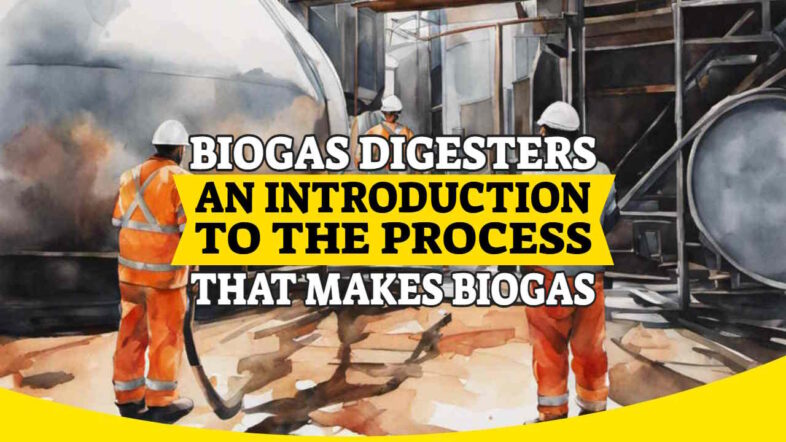In some countries, Biogas digesters have for a generation typically built underground to shield them from temperature variations, in hot countries, and likewise to avoid unintentional damage. These so-called rural community “biogas plants” provide the required conditions needed to keep the anaerobic bio-organisms inside healthily growing and producing the biogas.
Meanwhile, designs ideal for farms and neighbourhoods have been developed for the developing countries which have the ability to be duplicated making use of local masonry domed reactor tank building skills that are inexpensive, easy to source, and simple to assemble.
Introducing Anaerobic Digestion into Africa
There is a huge potential for further development of anaerobic digestion in Africa. An AGAMA Energy fact sheet estimates that in South Africa there are 400,000 homes with two or even more cows and no electricity that can utilize biogas digesters.
In a short article going back to 30 November 2005, in the Rwandan newspaper “The New Times”, specifies that the Institute for Scientific Study and Innovation in Kigali is preparing to install some 1,500 biogas digesters by 2009 in the Imidugudu settlements.
These are towns where rural Rwandans were moved after the genocidal wars of the mid-1990s.
The win-win procedure goes even more though due to the fact that the emission of contamination from the digester is quite lower than without the digester, too, so they can help to decrease river and groundwater contamination at the same time.
A practical biogas digester system applies the science of microbiology and is very much the sustainable development of a renewable resource when done right.
Biogas Digester Program
The biogas digester program is an effort to motivate an intro of appropriate and sustainable energy generation for the farming sector as well as promoting a holistic strategy to nutrient balancing and dirt management. The organization reinvests funds from the commercial biogas digester program into the installation of household-size rural family digesters to change the requirement for the event of wood fuel for dish preparation and heating. The digestate produced is used by placing it back onto farmland as a fertiliser.
Biogas digesters, which are also known as anaerobic digestion plants, are commonly considered to be something brand-new by those in established nations, nevertheless, they have actually been extensively used for several years in developing countries, specifically India and China, as firewood for food preparation ends up being limited. Other nations from Honduran farmers to the small South Pacific island nation of Tuvalu, are able to harness the methane gas created normally from decaying manure and other organic materials. Besides producing the fuel gas, these biogas digesters (utilizing the procedure of anaerobic digestion) have the added potential advantage of producing a high-nutrient slurry fertilizer and providing much better sanitation on farms.

The Ways to Make Biogas
There are 2 ways to make biogas. One is to make use of animal waste and the other is to utilize food waste. Both ways are really eco-friendly as wastes that would have developed pollution are now made use of to produce gas fuel. Biogas itself likewise produces no pollution during burning. Also, the residual product after the production of biogas can be used as fertilizer. The entire procedure is not only eco-friendly but also extremely effective as nothing is squandered. It is making use of food waste for a biogas digester making use of the waste kitchen scraps trashed in your home. This is because using animal waste is extremely inconvenient and the odour may be unpleasant to you and your neighbours.
Energy recovery is being attained by incineration of wastes, manufacturing of Refuse Derived Fuel (RDF) from wastes (normally in MBT plants), and the use of Anaerobic Digestion Plant kingdom (also called Biogas Digesters).
Self-Construction Savings vs Pre-built Biogas Digester
A pre-built biogas digester would cost you countless dollars. By building it yourself, the cost would be as low as $20. but, what you need is a very comprehensive do-it-yourself guide. I browsed for such a guide on the web. Most of them are incomplete and hard to comprehend. But finally, I found one that actually helps and with this guide, I effectively built my first biogas digester and delighted in the complimentary gas. I have no knowledge of this type of stuff, but the guide is really detailed so I can build it with no issue. You can too.
Agricultural Anaerobic Digestion
The biogas digester (anaerobic digestion plant AD plant) likewise, of course, has a big part to play in farming. An AD plant captures normally happening gas from manure and transforms it into electrical energy. One just such recently published United States Story states that with their brand-new AD system, they are creating up to 300,000 kilowatt-hours annually for their farm. That is a value in the power of about $40,000 a year!
Progression is happening, but more momentum is required if the sector is going to make a substantial contribution to greenhouse gas discharges in the next 10 years. Biogas digesters are not going to appeal to all. Biogas is among those matters where results do not come immediately. It can take a few weeks for procedure changes to take effect, so the modifications will be harder to manage than in other process plants, however, they do come.
Inexpensive Fossil Fuels Depress Biogas Development
In the United States, the availability of inexpensive fossil fuels has limited the use of digesters solely for biogas production. However, the waste treatment and odour reduction benefits of controlled anaerobic digestion are receiving increasing interest, especially for large-scale livestock operations such as dairies, feedlots, and slaughterhouses. In many cases, the economics of a system is not based on the lowest energy cost; but if a project can combine the on-farm benefits of a digester with a long-term contract for the biogas, the economics may make sense to either a farm or a developer. via www.wbdg.org
Acidogens and Methanogens
The anaerobic digestion process is carried out by a delicately balanced population of various bacteria. These bacteria can be very sensitive to changes in their environment and temperature is a prime example. The two types of bacteria (acidogens and methanogens) which are actively involved in anaerobic digestion operate at three different temperatures; psychrophilic or ambient temperature (< 25ºC), mesophilic (25-40°C) and thermophilic (45-60ºC) (El-Mashad, 2004).
Fluctuations in temperature can result in either a decrease in bacterial activity or death of bacteria subsequently leading to a decrease in biogas production. Insulation, heat exchangers, heating elements, water baths and steam injections are all means which have been used to control digester temperature. via scialert.net
Biogas output rate is a measurement of biogas production in the time period the material is expected to be in the digester.
A higher value of biogas output per tonne of volatile solids gives a higher energy yield. This number varies greatly depending on the type and condition of the material. Information from Germany indicates a range of 200 m3 to 4,500 m3 of biogas per tonne of volatile solids for different materials typically used in a digester. There are charts available giving a range of yields expected. via omafra.gov.on.ca
Conclusion – The Potential of Biogas Digesters
Biogas digesters are a versatile and sustainable solution with immense potential. These anaerobic digestion plants, known as biogas digesters, have been quietly revolutionizing communities and farms globally.
In some regions, biogas digesters are discreetly placed underground to protect them from damage and temperature fluctuations, ensuring healthy biogas production. These rural “biogas plants” offer clean, renewable energy while reducing pollution.
Africa presents a promising frontier for biogas digesters, providing reliable, sustainable energy to homes without electricity, often with livestock that can power these digesters.
Biogas digesters convert waste into valuable gas fuel while reducing pollution, making them vital for environmental sustainability. They can also be cost-effective when built using DIY guides, democratizing energy production.
In agriculture, biogas digesters capture methane from manure and convert it into electricity, reducing costs and environmental impact.
Although challenges remain, such as competition from cheap fossil fuels, the benefits of controlled anaerobic digestion are gaining recognition.
Temperature control is crucial for the delicate balance of acidogens and methanogens, the bacteria behind biogas digestion.
Understanding the biogas output rate is essential for optimizing performance and maximizing energy generation.
In summary, biogas digesters offer a sustainable, multi-faceted solution, that addresses pollution, resource conservation, sanitation, and clean energy. They hold the promise of shaping a greener future.
FAQs – Biogas Digesters
1. What is a biogas digester, and how does it work?
A biogas digester is a system that harnesses the natural process of anaerobic digestion to convert organic materials, such as animal waste or food scraps, into biogas, a renewable energy source primarily composed of methane. This process takes place in a sealed, oxygen-free environment and involves the activity of specific bacteria.
2. Why are some biogas digesters built underground?
Biogas digesters are sometimes built underground, especially in regions with extreme temperature variations or hot climates, to provide a stable environment for the anaerobic microorganisms. Underground placement helps maintain consistent temperatures and protects the digester from unintentional damage.
3. How do biogas digesters benefit rural communities in developing countries?
Biogas digesters, often referred to as “rural community biogas plants,” offer an opportunity for sustainable energy production and improved sanitation. They can provide clean energy for cooking and heating, reducing the reliance on firewood, while also minimizing the emission of pollutants and contaminants into rivers and groundwater.
4. Can biogas digesters be introduced in African countries?
Yes, there is significant potential for the development of anaerobic digestion, including biogas digesters, in Africa. Many African countries have livestock and agricultural waste that can be utilized for biogas production. Initiatives are underway to install biogas digesters in rural communities and settlements, providing both energy and environmental benefits.
5. What are the two main ways to make biogas?
The two primary methods of producing biogas are using animal waste and using food waste. Both approaches are environmentally friendly, as they convert organic waste into valuable biogas fuel while reducing pollution. Food waste may be preferred in some cases to avoid the inconvenience and odor associated with animal waste.
6. Is it more cost-effective to build your own biogas digester or buy a pre-built one?
Building your own biogas digester can be a cost-effective option, with the potential to save thousands of dollars compared to purchasing a pre-built system. Detailed DIY guides are available online to help individuals construct their digesters inexpensively. However, careful planning and adherence to safety guidelines are essential for successful construction.
7. How can biogas digesters benefit agriculture?
Biogas digesters play a significant role in agriculture by capturing methane gas from manure and converting it into electricity. This not only provides a renewable energy source but also helps reduce greenhouse gas emissions from agricultural operations.
8. Why is temperature control important in anaerobic digestion?
Temperature control is crucial in anaerobic digestion because the process involves two types of bacteria: acidogens and methanogens, which operate optimally at specific temperature ranges. Fluctuations in temperature can impact bacterial activity and biogas production. Therefore, various methods, such as insulation and heating elements, are used to maintain the desired temperature in the digester.
9. What is the biogas output rate, and why is it important?
The biogas output rate is a measurement of biogas production over a specific time period per unit of volatile solids in the material being digested. It is a crucial factor in assessing the efficiency and energy yield of a biogas digester. Different materials yield varying biogas output rates, and it is essential to consider this when designing and operating a digester.




